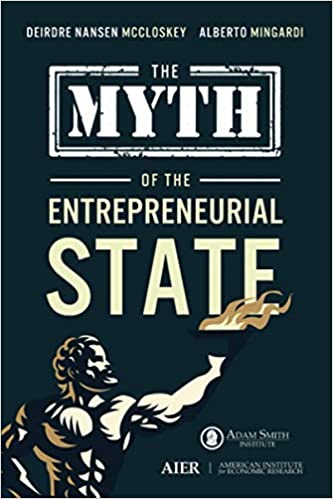What Drives Progress: The State or the Market?

The famous American author, Mark Twain once said, “History never repeats itself, but it does often rhyme.”
A little over a hundred years ago President Woodrow Wilson kicked off a drastic expansion of government power and scope with the general assumption that the state can scientifically plan society. President Franklin Roosevelt greatly expanded on this idea with more government programs that promised to solve all sorts of societal ills and bring a level of centralized progress that the market couldn’t provide. This sparked caution and critique from those who favored market-based mechanisms advocated by economists such as Ludwig Von Mises.
Those like AIER argued that the market was far superior to the state in organizing society. This is the story of humanity, a struggle between the individual and the state. Those who believe in statism and those who believe in liberty.
Some thought that the free marketeers won the intellectual argument against the Keynesian statists in the 1970s. This is when stagflation completely upended the assumption that inflation and unemployment are always inversely related. It turned out that simply using expansionary monetary policy to drive economic growth was not as good of an idea as people thought. Post World War Two, Keynesian and big-state thinkers more generally braced for economic turmoil as spending dropped and people returned from war. The exact opposite happened as we learned again that the state does not drive economic growth. In the latter half of the 20th century, sweeping market reforms brought prosperity to countries all around the world. Another blow to the idea of state-run industry.
In 2013 Dr. Mariana Mazzucato, a leading economist of the Keynesian persuasion, published The Entrepreneurial State, which makes the case that the public sector can do far more than it is currently doing. That the private sector necessarily needs generous guidance and intervention from the state and in many cases is equal if not superior to the market in generating efficient and innovative services to society.
Well, here we go again.
Mazzucato and her allies posit that society can be so much better if we ditched market-based principles and delegated more responsibility to the state. Think people like Senator Elizabeth Warren.
This is why it is so necessary that economic heavyweights Dr. Deirdre McCloskey and Dr. Alberto Mingardi teamed up to write The Myth of the Entrepreneurial State. In a perfect world, one should read Mazzucato’s work as well, but doing so is not necessary to understand this book. The book can surely stand its own as the debate between the market and the state is a timeless conversation. The book also serves as an outstanding work of economic history and elaborates on many relevant economic topics, making it well worth anyone’s time, not just those closely following this debate.
The Idea of the Entrepreneurial State
The authors quote Mazzucato when they note that she remarked,
“Mainstream policy conceptions and prescriptions” are “normative postulations for a permanent state planning for more markets, mainly organizing ‘deregulation cum privatization’ rather than deliberate sets of conditional recommendations based on pondering alternatives and paths.”
Essentially this suggests that mainstream economic thought is dominated by ideas put forth by those like Milton Friedman who advocate for more privatization and deregulation to create growth. Mazzucato believes that this is unpredictable and suboptimal. Rather we should allow experts to ponder better alternatives with a scientific level of precision. Mazzucato likes to reference government programs like DARPA and The Manhattan Project as examples that the government can be very innovative.
This is an odd assertion, as I would agree that many economists hold the belief that privatization and markets are good. However, McCloskey and Mingardi point out that
“In the past century, government expenditure as a percentage of GDP drifted up towards 50 percent, compared with its pre-Keynesian level of 10 percent”… “ Democratically elected politicians, and behind them their constituents in the voting public were finally convinced that budget balance carried little or no normative weight.”
Contrary to Mazzucato’s point, there is no widespread consensus about the wonders of privatization amongst policymakers, just sloppy never-ending spending, and expansion.
This is how government works, especially democracies. It’s sloppy, it’s imprudent, it’s cumbersome and utterly desensitized to important market forces. If you empower the state to take on more and more planning of society, this problem will only exacerbate.
This is why the traditional economic consensus is that the government should stick to prescribed collective action problems and the private sector is where most activity should be conducted.
The authors are less shy about explaining their issue with Mazzucato’s grand idea when they write,
Mazzucato, a loyal daughter of the left, is suspicious of private gain, of the sort you pursue when you are shopping, say, and is therefore suspicious of people doing things for a private reward. She wants the State, advised by herself, to decide for you.
In essence that is what the idea of the entrepreneurial state ultimately boils down to. A rationalization of leftist political economy that has politicians and university professors jumping for joy. A very mild form of central planning that says that great things are possible as long as I am in charge.
What Drives Innovation
One of the main premises of those who believe in an entrepreneurial state is that public investment drives innovation. Mazzucato contends that the government should exert a sort of directionality over private businesses to drive them towards some optimal point determined by experts.
However, this is a false view of how innovation happens. Innovation comes from the bottom up, not from the top down. Free people acting in spontaneous and self-interested ways create the innovative products of tomorrow. Private firms jockeying for supremacy in handheld communication gave us the genius of the iPhone. Tesla produces some of the most advanced electric cars in the world available for mass consumption. Tesla CEO Elon Musk is the antithesis of the pondering bureaucrats that Mazzucato believes drive innovation. A man who offers four car models named S, 3, X, Y, sells flame throwers, privatized the space race, and now just launched a line of tequila.
If anything Elon Musk’s personality might be the ideal representation of how innovation happens. Not by deliberate planning by experts but by the rambunctious and oftentimes chaotic enterprise of free individuals.
Mazzucato and others like her contend that the state drives innovation. The authors disagree and state that
“The spring, we say, was the liberal idea and its emancipation of human creativity.”
As statists lament over the alleged “normative postulation” regarding privatization, McCloskey and Mingardi feel exactly the opposite. Getting the state out of the way of free individuals is the driving force behind innovation.
Does Government Investment Contribute to Innovation?
One of the convincing arguments made by Mazzucato and others like her is that the advanced military research agency known as DARPA invented things like the internet. Therefore, the state may be capable of impressive feats of innovation. If we invested more, then we would get better results.
The authors offer a rebuttal that can be summarized as “important if true.” They write
“The question is whether the American government envisioned anything like the internet. The answer is obvious: of course it didn’t. There was no “mission-oriented directionality.” The investments by the military look like Christopher Columbus’ voyages: the entrepreneurial State discovered the West Indies having left for the East Indies.”
Furthermore,
“In the 1960s the Air Force considered how a decentralized communications grid distinct from the traditional telephone might operate. But the Department of Defense then terminated the research and took no action.”
The authors also go on to point out that one of the leading developers of ARPANET, the technical foundation for the modern internet, observed that
“DARPA “would never have funded a computer network to facilitate email” because the telephone already served person-to-person communications perfectly.”
This shows that government contribution to creating things like the internet was not only unintentional, it may have been detrimental. Innovation is a chaotic endeavor that requires testing in the marketplace rather than the approval of experts. If invention and progress rested on the opinions of whether a room full of PhD’s thought it would be productive, we might not have made it past the horse-drawn plow.
One famous example is the advent of airborne flight, which government officials and many others understandably believed after a failed test that air travel was not obtainable. Looking back, these comments seem comedic but if we allow the state and its army of experts to impose “directionality,” innovation would grind to a halt.
In fact, in 1903 the New York Times predicted that flight was approximately 1-10 million years away. Then just a couple of months later two bicycle mechanics, Wilbur and Orville Wright made the first functional airplane in their garage, proceeding to change the world forever.
Innovation happens in the absence of state direction. It’s not innovative if it was completely planned.
The authors go even further to point out that oftentimes innovation takes place to outmaneuver the state as regulations bog down progress in various industries. This can partially explain things like the emergence of private equity over public equity in the world of finance. One of the key benefits of private equity is not having to abide by the cumbersome regulations that govern public financial markets.
Key Takeaways
This debate between whether or not the state can be a competent and worthy driver of innovation is a necessary one. Although the state continues to grow regardless of who wins this intellectual argument, it was thought that proponents of limited government had won this discussion in the late 20th century when the world experienced a sweeping wave of liberalization.
Today we find ourselves at a crossroads, with much of the Western world embracing or starting to consider a view of government that sees it as much more than just a steward of our rights. They see the state as a force of positive and competent change in a capacity that McCloskey and Mingardi believe is only possible through the market. That a more powerful and unrestricted government can reliably be a steward of society.
The idea of an entrepreneurial state as proposed by Mazzucato is a romantic one. It’s an idea that people can come together and through sheer will can make innovation happen. That some very smart people with fancy degrees and prestigious titles can steer society to an optimal location. The only problem with that is just about everything.











